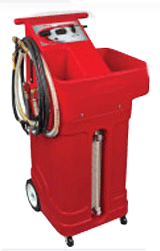|
||||||
   |
Differential Flush KitTHE PROBLEMPick-up trucks and SUV's represent a large and growing segment of the automotive market. These vehicles, combined with the rear-wheel drive passenger cars also on the road, constitute a huge population of two-wheel drive vehicles with one differential and four-wheel drive vehicles with two differentials. Most vehicle manufacturers recommend periodic replacement of the differential fluid, often at relatively frequent intervals. The recommended fluid change intervals can be as often as 3,000 to 5,000 miles for certain vehicles, with more common intervals being in the 15,000 to 30,000 mile range. Many vehicle owners are unaware that the recommended change intervals are this frequent. As differential cases do not normally contain both drain and fill plugs, it is often not a simple exercise to change the differential fluid. Often only a fill plug is present, leaving it to the service technician to determine the easiest and least messy procedure to drain the used fluid. Methods ranging from the use of hand operated or air powered evacuation devices to disassembly of the differential case to allow a gravity drain are in common use. In addition to problems encountered in attempting to drain the used differential fluid, similar problems may also be present when attempting to refill or merely top-off the differential. As the fill plug is located in the upper portion of the differential case and the differential itself often provides limited accessibility, refilling the differential, especially if dispensing from a gear oil container, can be quite time consuming and messy. As there is often not an easy, convenient and quick method for changing the differential fluid, the service is often neglected. Such neglect can contribute to a poor differential function, premature wear, noise and even premature failure. As changing the used fluid in manual transmissions and transfer cases can be a similarly tedious process, these fluid changes are also often neglected, possibly leading to the same kinds of long term problems including poor performance, premature wear and possible failure. THE SOLUTIONWynn's® DiffServ™ Differential Fluid Service Machine is a lightweight, roll-around, easy to use machine that provides the perfect solution to replacing differential fluid. A preformed suction hose fits easily into the differential fill plug opening, with the on-board pump providing a quick, easy and clean evacuation of the used fluid into the machine's on-board used fluid reservoir. When the machine's used fluid reservoir (45 qt capacity) is full, an on-board pump is used to easily remove it into a separate waste tank. Following evacuation of the used fluid, the trigger operated new fluid dispenser quickly and easily refills the differential with new fluid. Wynn's DiffServ machine is just as easy to use when performing fluid changes in a manual transmission or transfer case.* Wynn's DiffServ machine is designed for use with Wynn's 75W-90 Synthetic Gear Oil (# 11601), which is a GL-5 rated oil and satisfies most OEM requirements. This product is packaged in a 2 qt. container; an ideal package size for most differential services, and the gear oil is dispensed directly into the machine via a convenient suction hose. This machine is specifically designed for technicians who want to provide maximum customer satisfaction, by cleanly and efficiently performing a complete and necessary service in a minimum amount of time. For extra protection, use Wynn's High Performance Lube Supplement (#59419), which is formulated with additional EP (Extreme Pressure) and anti wear additives to improve gear oil performance. For those vehicles with limited slip differentials, we recommend that Wynn's Friction Modifier for Limited Slip Differentials (#64101) be added to the new gear oil. This product is designed to meet or exceed the limited slip performance requirements of most OEM's. Wynn's DiffServ Differential Fluid Service Machine is the ideal solution for differential fluid services. * Appropriate line flushing should be performed when changing fluid types to avoid contamination. Item |



